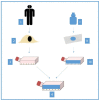Cytotoxicity of Self-Etch Versus Etch-and-Rinse Dentin Adhesives: A Screening Study
- PMID: 31963535
- PMCID: PMC7013582
- DOI: 10.3390/ma13020452
Cytotoxicity of Self-Etch Versus Etch-and-Rinse Dentin Adhesives: A Screening Study
Abstract
Six dentin adhesives were tested in vitro regarding their cytotoxicity on human fibroblasts. The adhesives Hybrid Bond, One-up Bond F Plus, AdheSE, Clearfil SE Bond, Optibond Solo Plus and Syntac were eluted with culture medium as single or sequentially applied adhesive part for 24 h. 75 Petri dishes were produced per group. They were evaluated triangulated, comprising the quantitative evaluation (105 ones) to determine "viable", "dead" and "debris" cells with the use of a cell-counter and the reactivity index was also identified based on the qualitative assessment (420 ones). One-up Bond F Plus, AdheSE and Clearfil SE Bond showed a statistical difference of viable cells to the cell control. For One-up Bond F Plus, statistically, differences compared to hybrid bond and Syntac were also found. All the adhesives except One-up Bond F Plus showed significant differences between single and sequentially applied adhesive part regarding the quantitative evaluation. The test material showed a moderate grade of cytotoxicity. As a result, a statistically significant difference of the cytotoxicity between the self-etch and etch-and-rinse adhesives cannot be demonstrated regarding the qualitative evaluation and the reactivity index, but the differences between sequentially applied and single applied components can be proved.
Keywords: cells; cytotoxicity; dentin adhesives; fibroblasts; in vitro; screening.
Conflict of interest statement
The authors declare no conflict of interest.
Figures











Similar articles
-
One-day bonding effectiveness of new self-etch adhesives to bur-cut enamel and dentin.Oper Dent. 2005 Jan-Feb;30(1):39-49. Oper Dent. 2005. PMID: 15765956
-
Effect of thermocycling on the durability of etch-and-rinse and self-etch adhesives on dentin.Dent Mater J. 2016;35(3):360-8. doi: 10.4012/dmj.2015-253. Dent Mater J. 2016. PMID: 27251990
-
Microtensile bond strength to dentin and enamel of self-etch vs. etch-and-rinse modes of universal adhesives.Am J Dent. 2019 Aug;32(4):174-182. Am J Dent. 2019. PMID: 31436937
-
Enamel and dentin bond strengths of a new self-etch adhesive system.J Esthet Restor Dent. 2011 Dec;23(6):390-6. doi: 10.1111/j.1708-8240.2011.00465.x. Epub 2011 Oct 17. J Esthet Restor Dent. 2011. PMID: 22142299
-
Status of ten self-etch adhesives for bonding to dentin of primary teeth.Int J Paediatr Dent. 2014 May;24(3):192-9. doi: 10.1111/ipd.12059. Epub 2013 Aug 6. Int J Paediatr Dent. 2014. PMID: 23919411
Cited by
-
Cytotoxic effects on human dental pulp stem Cells after exposure to adhesive bonding agents.Braz Dent J. 2024 Jun 24;35:e245529. doi: 10.1590/0103-6440202405529. eCollection 2024. Braz Dent J. 2024. PMID: 38922248 Free PMC article.
-
Detection of Inflammatory and Homeostasis Biomarkers after Selective Removal of Carious Dentin-An In Vivo Feasibility Study.J Clin Med. 2021 Mar 2;10(5):1003. doi: 10.3390/jcm10051003. J Clin Med. 2021. PMID: 33801317 Free PMC article.
-
Cytotoxicity of V-Prep Versus Phosphoric Acid Etchant on Oral Gingival Fibroblasts.J Funct Biomater. 2022 Nov 28;13(4):266. doi: 10.3390/jfb13040266. J Funct Biomater. 2022. PMID: 36547526 Free PMC article.
-
Cytotoxicity of Calcium Silicate-Based Cements: Role of Bonding Time, Strategy, and Thickness in an In Vitro Model.Iran Endod J. 2025;20(1):e20. doi: 10.22037/iej.v20i1.46162. Epub 2025 Mar 17. Iran Endod J. 2025. PMID: 40206781 Free PMC article.
-
Investigation of the cytotoxic effect of current dentine bonding agents on human dental pulp cells.BMC Oral Health. 2024 Oct 10;24(1):1207. doi: 10.1186/s12903-024-04985-1. BMC Oral Health. 2024. PMID: 39390415 Free PMC article.
References
LinkOut - more resources
Full Text Sources
Research Materials

